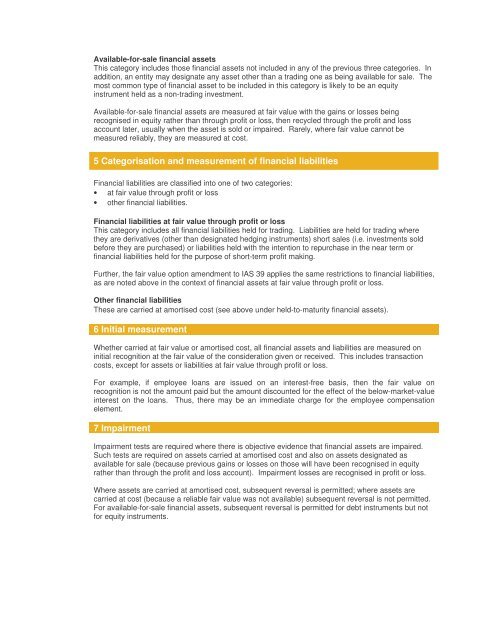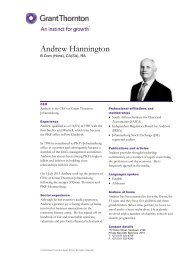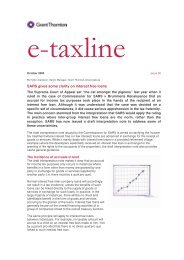e-IFRSline May 06 - IAS 39: Financial Instruments - Grant Thornton
e-IFRSline May 06 - IAS 39: Financial Instruments - Grant Thornton
e-IFRSline May 06 - IAS 39: Financial Instruments - Grant Thornton
- No tags were found...
You also want an ePaper? Increase the reach of your titles
YUMPU automatically turns print PDFs into web optimized ePapers that Google loves.
Available-for-sale financial assetsThis category includes those financial assets not included in any of the previous three categories. Inaddition, an entity may designate any asset other than a trading one as being available for sale. Themost common type of financial asset to be included in this category is likely to be an equityinstrument held as a non-trading investment.Available-for-sale financial assets are measured at fair value with the gains or losses beingrecognised in equity rather than through profit or loss, then recycled through the profit and lossaccount later, usually when the asset is sold or impaired. Rarely, where fair value cannot bemeasured reliably, they are measured at cost.5 Categorisation and measurement of financial liabilities<strong>Financial</strong> liabilities are classified into one of two categories:• at fair value through profit or loss• other financial liabilities.<strong>Financial</strong> liabilities at fair value through profit or lossThis category includes all financial liabilities held for trading. Liabilities are held for trading wherethey are derivatives (other than designated hedging instruments) short sales (i.e. investments soldbefore they are purchased) or liabilities held with the intention to repurchase in the near term orfinancial liabilities held for the purpose of short-term profit making.Further, the fair value option amendment to <strong>IAS</strong> <strong>39</strong> applies the same restrictions to financial liabilities,as are noted above in the context of financial assets at fair value through profit or loss.Other financial liabilitiesThese are carried at amortised cost (see above under held-to-maturity financial assets).6 Initial measurementWhether carried at fair value or amortised cost, all financial assets and liabilities are measured oninitial recognition at the fair value of the consideration given or received. This includes transactioncosts, except for assets or liabilities at fair value through profit or loss.For example, if employee loans are issued on an interest-free basis, then the fair value onrecognition is not the amount paid but the amount discounted for the effect of the below-market-valueinterest on the loans. Thus, there may be an immediate charge for the employee compensationelement.7 ImpairmentImpairment tests are required where there is objective evidence that financial assets are impaired.Such tests are required on assets carried at amortised cost and also on assets designated asavailable for sale (because previous gains or losses on those will have been recognised in equityrather than through the profit and loss account). Impairment losses are recognised in profit or loss.Where assets are carried at amortised cost, subsequent reversal is permitted; where assets arecarried at cost (because a reliable fair value was not available) subsequent reversal is not permitted.For available-for-sale financial assets, subsequent reversal is permitted for debt instruments but notfor equity instruments.










